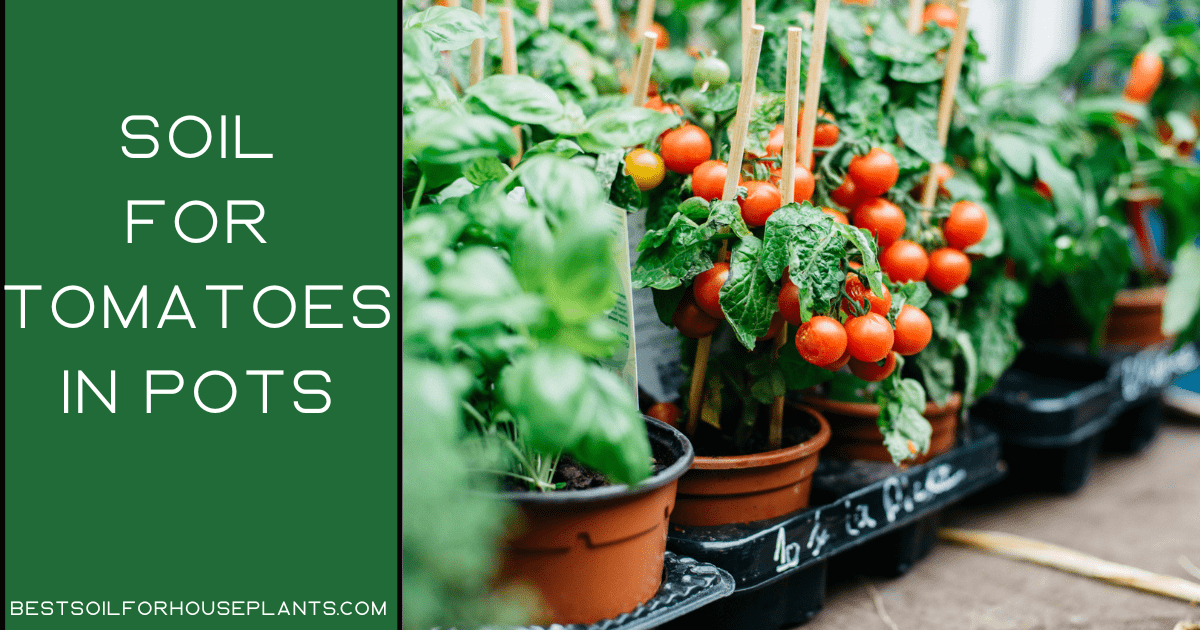Summertime is the tomato growing season! Even though growing tomatoes is relatively simple, the choice of the right high-quality soil for tomatoes in pots should be taken seriously. The taste of your tomatoes can vary significantly depending on what kind of potting soil and plant food you use.
We will cover some factors and aspects that you should consider when picking a potting mix or a fertilizer for growing tomatoes, and we will also give you some examples of good potting soils that are not expensive. Best soil for tomatoes in pots:
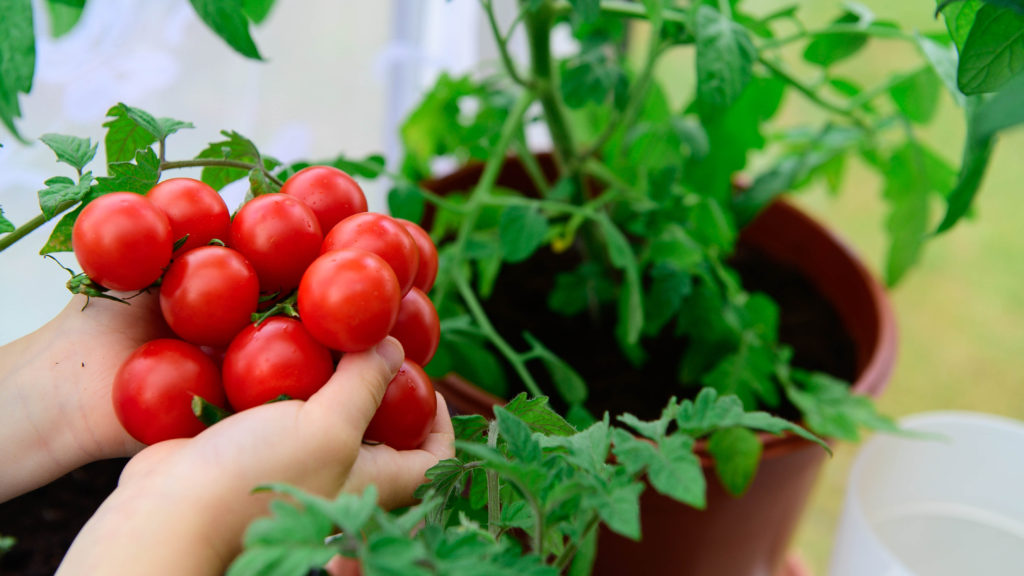
What does soil for tomatoes in pots look like?
Tomatoes grow well in most types of garden soil. The kind of soil that you should avoid using for tomatoes is clay soil. Due to its high density and water retention, root growth is obstructed. Tomatoes prefer soil with good drainage and enough water retention to fulfill their moisture requirements. Soil with lots of organic materials will be great too.
So the perfect potting soil for tomatoes would be well-aerated, well-drained but moisture-retaining, full of organic matter and nutrients. It should have higher levels of phosphorus and potassium along with a slightly acidic soil pH level of 6-6.8.
The way of growing tomatoes will also affect your decision. If you plan to start the seeds in soil, you should aim for much lighter potting soil mixes. When planting tomato seedlings, a denser kind of soil is used.
Let’s start with particular factors you should consider while choosing a potting mix for your tomato plants.
What to consider when preparing soil for tomatoes. Best soil for tomatoes in pots.
1. Amount of soil for tomatoes in pots
The container should be at least 5 gallons large. A 10 gallon container would be ideal. A wider container is preferred for growing tomatoes because their roots grow more wide than deep.
2. The soil depth
As mentioned earlier, tomatoes’ roots don’t grow very deep down, they usually spread out instead. The core root system of a tomato plant is located within the first foot below surface. So, a soil depth of 8-12 inches is enough for potted tomatoes. You should loosen the soil all the way down using a trowel to get the best aeration.
If you transplant a young tomato plant into a pot or container, you want to put it at least 3-4 inches deep. This way the plant will be stronger once the roots grow out.
3. The potting mix additives
You cannot just fill your container for tomatoes with garden soil, because it drains too quickly, you would have to water it several times a day. Garden soil is also more easily compressed over time, which is bad for tomato roots.
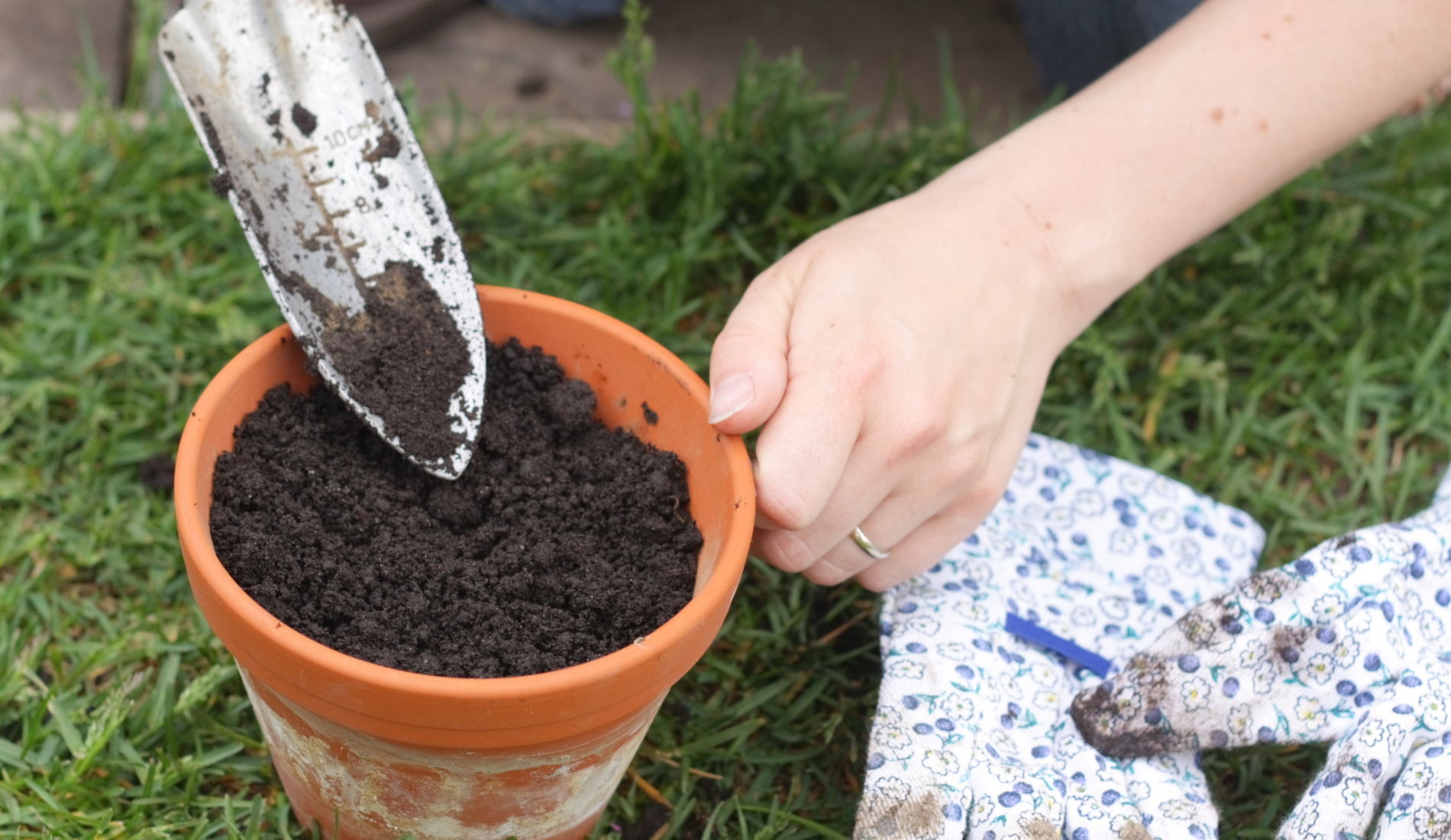
Just like with houseplants, you want to use commercial potting mix for growing tomatoes or make such mix on your own. As an option, you can take some well-suited potting soil and mix it with the soil from your garden, which will give you a good amount of substrate.
Commercial potting mixes usually include ingredients that improve drainage, water retention ability, porosity, pH balance and other factors.
Most common of them are listed below:
- Peat moss. It’s usually the main component in potting soils including tomato and vegetable blends. Peat moss absorbs water and gradually releases it over time to keep the tomato roots wet.
- Coco coir. It is a peat moss alternative. Coir prevents soil compression, absorbs moisture and releases it slowly to keep plants roots wet, the way that moss does it.
- Bark. It is harvested from pine or fir trees. Bark helps make the potting soil less dense and more aerated so the roots have more room to grow and more access to the air.
- Perlite & vermiculite. These are both byproducts of volcanic glass. Perlite makes soil more porous and aerated, preventing soil compaction. Vermiculite acts in a similar way, but it tends to retain more moisture. So good horticultural grade perlite should be used for tomatoes, because they prefer a less moistened environment.
- Sand. Horticultural sand can be used in soil to improve drainage. It can also strengthen the soil structure so roots can be anchored more easily. This way tall tomato plants will not fall over.
- Wetting agent. Some potting soils are semi-damp when packaged and others are completely dry. You can face some problems while moistening dry peat moss mixes for the first time: the moss floats rather than absorbs water. Wetting agent helps the moss absorb water during the first moistening. After that the moss has no problem absorbing water.
- Earthworm castings. They act more like a fertilizer. Earthworm castings are worm feces that contain nutrients and beneficial bacteria and are found in many mixes.
Here are some factors that affect tomato growth and development:
4. Soil type
Tomatoes can grow in most potting soils except clay soils which happen to be too heavy. A loose soil is optimal for tomato plants.
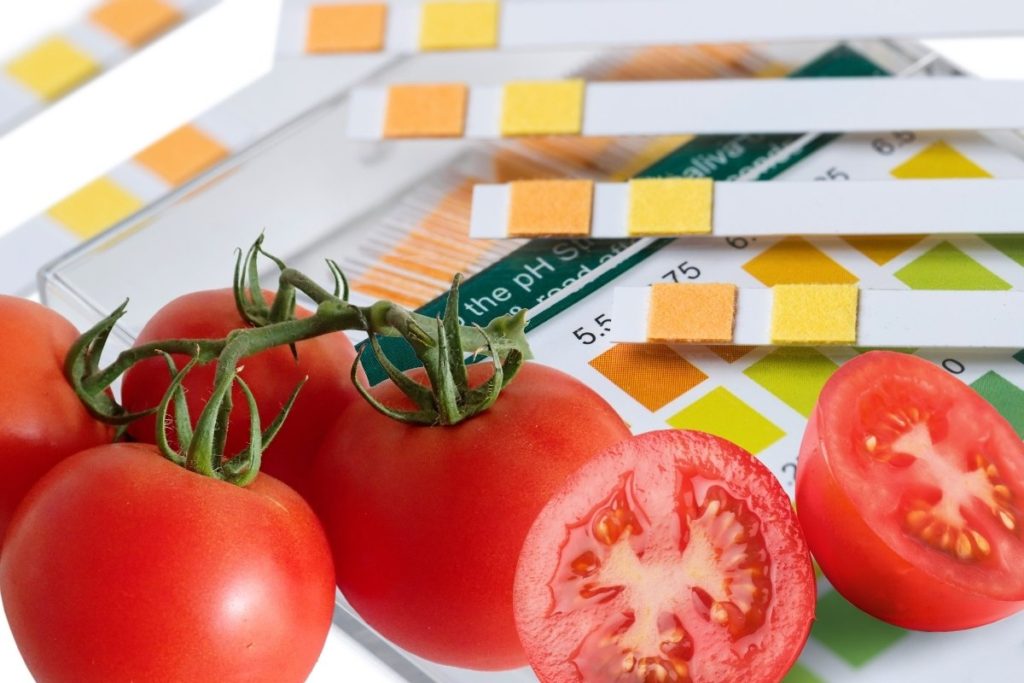
5. Soil pH level
The ideal pH level for tomatoes is 6.0 to 6.8 (slightly acidic). Tomatoes can still grow in the range of 5.5 to 7.5. Potting soil that contains some organic materials like dried leaves or compost usually matches this range. Not every commercial potting soil comes with its pH level written on the bag. You can easily determine pH of the soil with a cheap soil tester available at any garden center or on Amazon.
6. Moisture level
Tomato roots don’t like it is high or low. The potting soil for tomatoes is supposed to be well-drained so it stays moist but not too soggy. Soil that is too damp will cause root rot. That’s why it is advised to have some coco coir, peat moss or perlite in the soil mix.
7. Food and nutrients
Make sure your tomato plants have a constant supply of food during the whole season. Tomatoes generally love lots of nutrients. They need the soil to be rich in organic matter and micronutrients such as phosphorus, potassium, calcium and magnesium. Phosphorus and potassium promote flowering and help growing healthy tomatoes. A sufficient level of Calcium helps inhibit blossom end rot.
That’s why tomato fertilizers are high in phosphorus. You can see that in the middle number of the product’s nitrogen (N), phosphorus (P), and potassium (K) ratio. This number is high compared to the other two numbers, for example, 8-15-6 or 5-7-3. The ratio itself does not have to be exactly like these two, it can vary among different fertilizers.
As mentioned before, tomatoes’ flavor is greatly affected by the potting soil you plant tomatoes in, so make sure you place your tomatoes in a nutrient-rich organic soil!
Summary
The perfect soil for potted tomatoes is a loose soil that holds enough water to prevent the roots from drying out, contains lots of potassium & phosphorus, and has a pH level of 6-7.
Preparing your own soil for tomatoes in pots
If you actually want to prepare your own potting soil mix instead of buying one, here’s a short recipe that uses the ingredients we’ve talked about before:
- 25% Garden soil or topsoil from your backyard. Make sure it does not have a high level of clay in it. If your soil is too clayey then try to lower its quantity and add more perlite and coco coir to the mix, also loosen the soil and break all the clumps before mixing.
- 25% Perlite/Vermiculite
- 25% Coconut coir/Sphagnum peat moss
- 25% Compost/Decomposed cow manure or some organic components such as leaves, vegetable scraps, etc.
Warning
Using your garden soil is risky as it can contain weed seeds, insect eggs and larvae, fungi and other pests which can cause disease in your plants. That is why you should sterilize the soil before using it.
If you don’t want to make your own soil, you can always buy a commercial potting mix.
Commercial potting mix recommendations
1. FoxFarm Ocean Forest FX14000 Organic Potting Soil (may be the best potting soil in general)
This rich in organic matter mix is perfectly suited to growing tomatoes. It has a good balance of peat moss, sandy loam and forest humus. Ocean Forest provides tomato plants with ideal drainage and no soil compression over time. It can retain moisture long enough between waterings too. The additives in the soil mix are natural ingredients, such as bat guano, fish and crab meal, earthworm castings. Ocean Forest has a suitable pH level of 6.3 – 6.8, which is just what tomatoes need.

Components: peat moss, sandy loam, forest humus
Nutrients: Bat guano, fish meal, crab meal, earthworm castings
You can get the FoxFarm potting soil at Amazon, The Home Depot or Walmart.
2. FoxFarm FX14047 2-Cubic Feet Happy Frog Potting Soil (best nutrients)
This is another shopping FoxFarm potting soil mix that is rich in organic matter and natural ingredients. It is composed of sphagnum peat moss, forest humus and perlite. This combination offers a soil that drains well yet retains enough moisture between waterings to keep tomatoes from drying out.
Happy Frog is a pH-adjusted growing mix that has a pH level of 6.3 – 6.8, which is perfect for growing tomatoes in pots. Some natural microbes and micronutrients are added so the blend has more nutritional value than the previous FoxFarm product. Additives include ground oyster shell and Leonardite, which is a soil conditioner. Each soil amendment works to balance the soil pH level.
Components: peat moss, forest humus, perlite
Nutrients: bat guano, humic acid, earthworm castings, ground oyster shells, different additional micronutrients
You can buy the FoxFarm potting soil on Amazon or at Walmart.
3. Black Gold All Organic Potting Soil (best organic)
It was shown by OMRI certification that this potting soil consists of natural components only and is free from chemicals.
It is a blend of loam and sphagnum peat moss with perlite and pumice stone mixed in. Pumice is a type of lightweight volcanic rock, its pieces help the soil drain well. They also improve its structural integrity so the tomato roots could be anchored more firmly.
Components: Peat moss, loam, perlite, pumice stone
Nutrients: Compost, forest humus, earthworm castings
You can buy the Black Gold potting soil on Amazon or at Walmart.
4. Espoma Organic Potting Soil Mix (best moisture control)

If you live in a warm climate, you should water your tomatoes more frequently. The Espoma potting mix promotes root growth for increased water uptake and reduces any drought stress. This is made possible due to the myco-tone – the company’s exclusive blend of mushroom-based ingredients. The soil actually makes plants use up to 30% less water while remaining healthy. The added limestone helps adjust the pH level.
Components: sphagnum peat moss, humus, perlite, limestone
Nutrients: Earthworm castings, myco-tone (seven species of ectomycorrhizal fungi and four species of endomycorrhizal fungi), feather meal, kelp meal, alfalfa meal.
You can get the Espoma potting mix on Amazon or at Walmart.
5. Miracle-Gro Potting Soil Mix (25-quart) (one of the best by price)
Miracle-Gro potting soil mix is a relatively cheap and all-purpose option but it will give your tomato seedlings a great start. It has a standard blend of sphagnum peat moss, coconut coir and perlite. A wetting agent is also included to help the dry peat moss absorb water instead of floating on it the first time you moisten it. After the first moistening the soil mix will absorb water quickly.

Like most Miracle-Gro soil blends, this one has fertilizers already added to the potting mix. They will give young tomato plants an initial burst of growth, so you don’t have to worry about fertilizing them for a couple of months. After that, tomatoes should be regularly fed about every 6 weeks. We will discuss suitable fertilizers for tomatoes in a moment.
Components: peat moss, coco coir, perlite, wetting agent
Nutrients: fertilizer
You can find this Miracle-Gro potting soil at Amazon, The Home Depot and Walmart.
6. Hoffman Seed Starter Mix (best for seed starting)
Seed starting soil mixes are designed to give seeds the best conditions for growing into healthy seedlings. In order to start the seeds instead of planting seedlings right away, you need a more loose and light type of soil. If you plan to start your tomatoes by first growing the seeds in the soil, this Hoffman seed starter potting mix will help you make it much more quickly.
Components: Canadian sphagnum peat moss, limestone (pH adjuster), vermiculite, wetting agent
Nutrients: –
You can get the Hoffman potting mix on Amazon.
7. Burpee Organic Premium Potting mix (one of the best by price)

This Burpee potting mix is suitable for growing tomatoes along with flowers and herbs. It is labeled for organic use by OMRI (organic materials review institute), which means it doesn’t contain any artificial chemicals at all. The potting mix includes both slow and fast nutrients needed for your tomato plants. This means that the blend will release some essential nutrients immediately after planting and continue to provide a steady nutritious stream for up to 3 months. The mix also has an improved water retaining capacity to maintain moisture between waterings.
You can get Burpee Organic Premium potting soil on Amazon.
8. Compressed Organic Potting Soil for Garden by Organic Plant Magic
When mixed with water, a single bag of compressed organic potting soil expands up to 7 times the size! The compression technology makes it easy to carry and store the bag of soil.
The mix also has all the advantages of a high-quality soil mix: it has plenty of nutrients that feed your plants for several months, has a water holding capacity that is 50% higher than that of common potting soil, and contains coco coir, worm castings, and some bacteria. All of it makes this compressed soil a great option for growing tomatoes in raised garden beds.
Components: coconut coir
Nutrients: worm castings, fertilizer
You can get this Compressed organic potting soil on Amazon.
Fertilizers for tomatoes
Tomatoes demand lots of nutrients so lots of food is required. You can use additional fertilizer to support your tomato plants. In case of growing tomatoes in containers, nutrients are washed out by water via the draining holes, so using a solid fertilizer is a good alternative.
When should I add a fertilizer to the potting soil in containers?
When you are using a fertilized potting mix, you don’t have to add any extra fertilizer when transplanting the young tomato plants. Too much fertilizer will just burn the young roots. You can start adding fertilizers after 2 weeks or just when the tomatoes appear. After that the plants will require a constant nutrient supply to produce juicy and tasty tomatoes.
What fertilizer do I choose for tomatoes?
The best fertilizer for tomatoes is supposed to be rich in phosphorus and potassium compared to nitrogen. Fertilizer with a higher PK value e.g. NPK 5-10-10 would be optimal. Nitrogen is needed for leaves growth, phosphorus is vital for growing healthy flowers and fruits.
We will give you some recommendations on good fertilizers too.
1. Tomato Secret by Dr. JimZ
- Contains 12 natural ingredients
- Includes alfalfa meal, soybean meal, rock phosphate, calcium carbonate, magnesium sulfate, sugar cane molasses
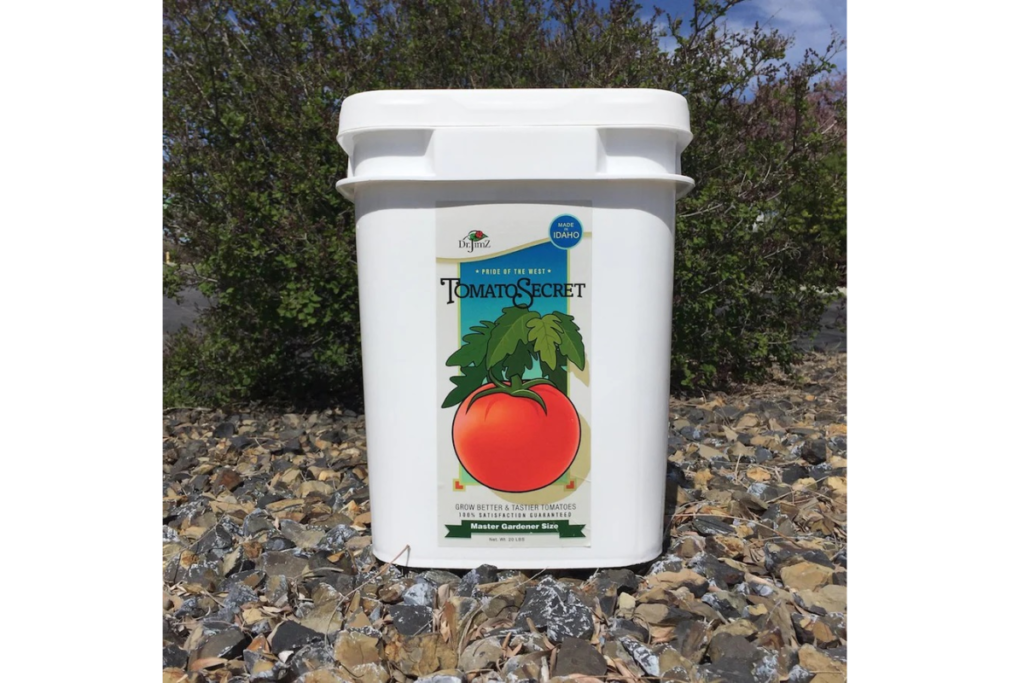
If you are using a rich potting soil mix, add 1 cup of the fertilizer after at least 2 weeks since transplant. Then sprinkle a handful every 2-3 weeks around your plant.
For a regular potting mix: just before planting tomatoes, add 1 cup under 5-6 inches of soil and cover it with a layer of soil. Then sprinkle the same way.
2. Burpee Organic Tomato Food
- Natural and organic
- Contains beneficial microbes and essential nutrients with no chemicals
- the NPK ratio is 3-6-4
If you are using a rich potting mix, add half a handful around the plant only after 2 weeks since transplant. Sprinkle it around the plant once a month.

If you are using a generic potting mix, sprinkle half a handful at the time of transplant, and apply once a month.
Do you know which soil is the best for houseplants? Read about it in our web.
FAQs
Do tomatoes really like acidic soil?
Tomatoes like only slightly acidic soil, ranging from 6 to 7 on the pH scale (the neutral being 7).
How do I raise or lower the pH for potted tomatoes?
You can adjust acidic soil (with pH lower than 6) by adding ground lime – this will raise the pH level. To lower the pH of alkaline soil (with pH higher than 7), you may add compost or peat moss.
What sort of compost is best for tomatoes?
Any type of natural organic compost like composted wood chips, composted bark, household compost, or commercial compost will add the needed nutrients to the soil and feed tomato plants.
Avoid using composted manure, as it can be too strong and might even burn tomato plant roots. In any case, follow the application instructions of the products carefully.
Is it better to grow tomatoes in pots or in grow bags?
Both are equally ok. For the best results, pick the pot or bag that holds at least 5 gallons of soil so the tomato roots will have enough room to expand.
Is Miracle-Gro potting soil good for tomatoes?
Yes, it provides an ideal soil for tomatoes in pots. The reason why it might be avoided is synthetic fertilizers that are not organic.
Is Coffee Grounds good for tomatoes?
Yes, you can use coffee grounds as a source of Nitrogen (N). But you should not use more than 15-20% of it in your soil mix. Remember that tomatoes need more phosphorus (P) and potassium (K) for fruiting. Coffee powder can also repel snails and slugs along with other pests.
Is Epsom salt good for tomatoes?
Yes, Epsom salt contains magnesium and sulfur, so it can act as some sort of a fertilizer.
How much Epsom salt do you use?
For a 2 feet tall tomato plant, dilute 2 tbsp Epsom salt with 1 gallon of water. You can either use spray it over the leaves or pour it on the soil once a month.
Can you grow tomatoes in 5-gallon buckets?
Yes, this volume is enough.
Are banana peels good for tomato plants?
Yes, banana peels are a good source of phosphorus and potassium which are very useful nutrients for growing tomatoes. You should dry the peels first and then put them into soil.
Is bone meal good for tomatoes?
Yes. Bone meal is a great source of phosphorus and calcium, which are both important nutrients. By adding it to your soil you will strengthen the tomato stems and prevent blossom end rot.
Are orange peels good for tomatoes?
Yes, orange peels are a good source of Nitrogen (N). Cut some peals into tiny bits so they compost well.
Are eggshells good for tomato plants?

Yes, eggshells contain lots of calcium, which helps prevent blossom end rot and produce healthy tomatoes. Crash your eggshells in a grinder to a fine powder and apply it to your soil for tomatoes. Do not breathe in eggshell powder, you should wear a mask while grinding and applying.
Conclusion
We have covered all the factors that you should pay attention to when choosing the right soil for tomatoes in pots. Now you can pick the best potting soil from our selection and enjoy growing healthy and tasty tomatoes.
And remember to always wait for the tomatoes to ripen completely, and only then collect and eat them – that’s how you get the most flavorful tomatoes!

